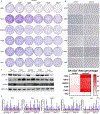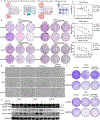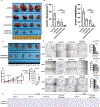Osalmid sensitizes clear cell renal cell carcinoma to navitoclax through a STAT3/BCL-XL pathway
- PMID: 39894195
- PMCID: PMC12236298
- DOI: 10.1016/j.canlet.2025.217514
Osalmid sensitizes clear cell renal cell carcinoma to navitoclax through a STAT3/BCL-XL pathway
Abstract
Clear cell renal cell carcinoma (ccRCC) is a common and lethal urinary malignancy characterized by its resistance to apoptosis. Despite the emerging treatment options available for ccRCC, only a small proportion of patients achieve long-term survival benefits. Previous studies have demonstrated that inducing tumor cell senescence, followed by treatment using senolytics, represents a potential strategy for triggering tumor cell apoptosis. However, it remains unclear whether this strategy is suitable for the treatment of ccRCC. Using the whole-genome CRISPR screening database Dependency Map portal (DepMap), we identified ribonucleotide reductase family member 2 (RRM2), which catalyzes the conversion of ribonucleotides to deoxyribonucleotides (dNTPs), as an essential targetable gene for ccRCC. Herein, we report that the combination of the choleretic drug osalmid targeting RRM2 and the senolytic compound navitoclax targeting BCL-XL represents a novel therapeutic approach for ccRCC. Furthermore, we have validated this approach across a panel of human ccRCC cells with different genetic backgrounds and multiple preclinical models, including cell line-derived xenografts (CDX), patient-derived xenografts (PDX), and patient-derived organoids (PDO). Mechanistically, osalmid-mediated inhibition of dNTPs generation induces cellular senescence in ccRCC, concomitant with STAT3 activation and upregulation of BCL-XL, thus rendering these cells vulnerable to navitoclax, which targets the BCL-2 protein family.
Keywords: Apoptosis; BCL-XL; Cellular senescence; Clear cell renal cell carcinoma; RRM2.
Copyright © 2025 The Authors. Published by Elsevier B.V. All rights reserved.
Conflict of interest statement
Declaration of competing interest The authors declare that they have no known competing financial interests or personal relationships that could have appeared to influence the work reported in this paper.
Figures





Similar articles
-
A Mesenchymal Tumor Cell State Confers Increased Dependency on the BCL-XL Antiapoptotic Protein in Kidney Cancer.Clin Cancer Res. 2022 Nov 1;28(21):4689-4701. doi: 10.1158/1078-0432.CCR-22-0669. Clin Cancer Res. 2022. PMID: 35776130 Free PMC article.
-
Targeting Bcl-xL with Navitoclax Effectively Eliminates Senescent Tumor Cells That Appear Following CEP-1347-Induced Differentiation of Glioma Stem Cells.Int J Mol Sci. 2025 Jul 20;26(14):6984. doi: 10.3390/ijms26146984. Int J Mol Sci. 2025. PMID: 40725230 Free PMC article.
-
Apoptotic priming in senescence predicts specific senolysis by quantitative analysis of mitochondrial dependencies.Cell Death Differ. 2025 May;32(5):802-817. doi: 10.1038/s41418-024-01431-1. Epub 2025 Jan 6. Cell Death Differ. 2025. PMID: 39762561
-
A Systematic Review and Meta-analysis Comparing the Effectiveness and Adverse Effects of Different Systemic Treatments for Non-clear Cell Renal Cell Carcinoma.Eur Urol. 2017 Mar;71(3):426-436. doi: 10.1016/j.eururo.2016.11.020. Epub 2016 Dec 8. Eur Urol. 2017. PMID: 27939075
-
CYP1B1 promotes angiogenesis and sunitinib resistance in clear cell renal cell carcinoma via USP5-mediated HIF2α deubiquitination.Neoplasia. 2025 Aug;66:101186. doi: 10.1016/j.neo.2025.101186. Epub 2025 May 27. Neoplasia. 2025. PMID: 40435846 Free PMC article. Review.
Cited by
-
Cellular senescence in cancer: from mechanism paradoxes to precision therapeutics.Mol Cancer. 2025 Aug 8;24(1):213. doi: 10.1186/s12943-025-02419-2. Mol Cancer. 2025. PMID: 40781676 Free PMC article. Review.
References
-
- Bukavina L, Bensalah K, Bray F, Carlo M, Challacombe B, Karam JA, et al. Epidemiology of Renal Cell Carcinoma: 2022 Update. Eur Urol 2022;82(5):529–42. - PubMed
-
- Xie R, Cheng L, Huang M, Huang L, Chen Z, Zhang Q, et al. NAT10 Drives Cisplatin Chemoresistance by Enhancing ac4C-Associated DNA Repair in Bladder Cancer. Cancer Res 2023;83(10):1666–83. - PubMed
-
- Bedke J, Albiges L, Capitanio U, Giles RH, Hora M, Lam TB, et al. The 2021 Updated European Association of Urology Guidelines on Renal Cell Carcinoma: Immune Checkpoint Inhibitor-based Combination Therapies for Treatment-naive Metastatic Clear-cell Renal Cell Carcinoma Are Standard of Care. Eur Urol 2021;80(4):393–7. - PubMed
-
- Aldea M, Andre F, Marabelle A, Dogan S, Barlesi F, Soria JC. Overcoming Resistance to Tumor-Targeted and Immune-Targeted Therapies. Cancer Discov 2021;11(4):874–99. - PubMed
MeSH terms
Substances
Grants and funding
LinkOut - more resources
Full Text Sources
Medical
Research Materials
Miscellaneous

